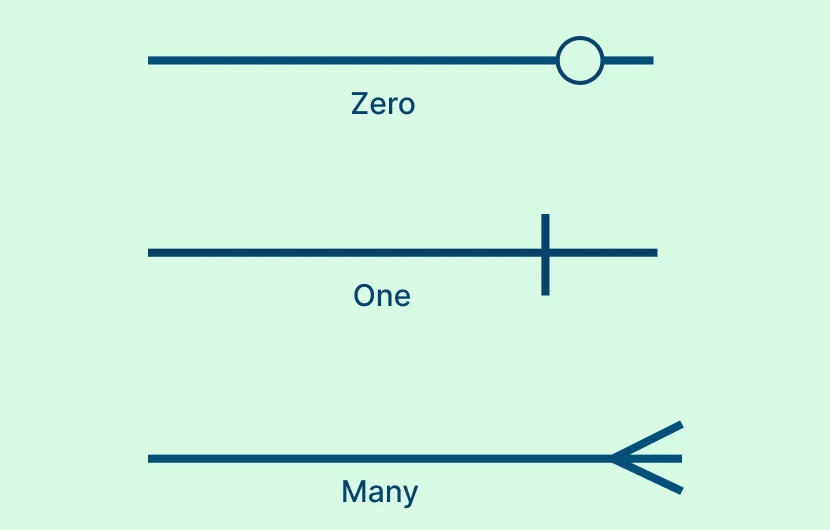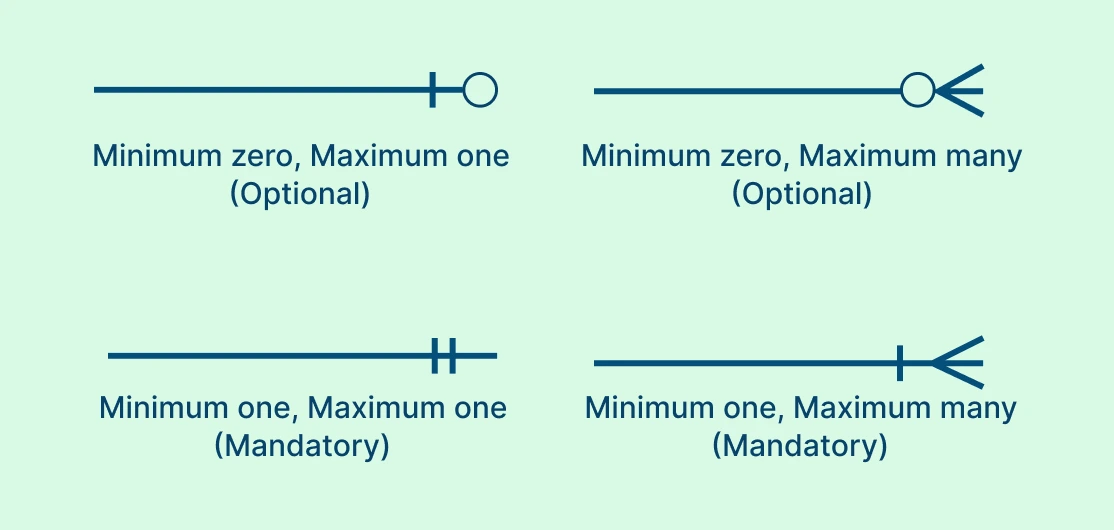Crow’s Foot notation is a powerful and widely used method for visually representing relationships in database modeling. Its distinctive symbols such as dashes, circles, and the ‘crow’s foot’ shape help define the connections between entities, making database structures easier to interpret.
This guide explores the meaning behind the crow’s foot notation symbols, explains how they indicate cardinality, and provides a step-by-step tutorial to help you create a simple database using Creately. We have also provided you with links to Creately’s ER diagram template collection, a brief history of the crow’s foot style of notation symbols and best practices for using it. Whether you’re a beginner or an experienced database designer, mastering these symbols will enhance your ability to model complex data relationships effectively.
What is Crow’s Foot Notation
Crow’s Foot notation is a widely used method for representing relationships in Entity-Relationship Diagrams (ERDs). It visually illustrates how entities (tables) in a database interact with each other using specific symbols that, as the name implies, resemble a crow’s foot. This notation style is also known as Information Engineering (IE) notation.
How to Read Crow’s Foot Diagrams
In this section, you will learn how to read the ER diagrams made with crow’s foot notation.
Interpreting entities, attributes, and relationships
Just like in most types of ER diagrams, crow’s foot notation involves entities, attributes and relationships. Entities are the real-world objects or concepts that the database is tracking and storing data on. Attributes are the properties that describe these entities.
In the example below, you will see a visual representation for an entity called ‘User’ and the same entity with its attributes attached.

An entity can have a relationship with another entity. In database modeling, we utilize connecting lines to indicate these relationships. Furthermore, we use symbols on the ends of connecting lines to convey the nature of the relationship. This is where crow’s foot notation symbols have a role to play.
Crow’s Foot Notation Symbols
The main symbols used in crow’s foot style are the ‘zero’, the ‘one’ and the ‘many’. The ‘zero’ symbol denoted by a circle at the end, conveys that it is an optional relationship. The minimum number of related entities could be zero.
The ‘one’ symbol indicated by a short vertical line or dash means it is a mandatory relationship with a minimum of at least one related entity.
The ‘many’ symbol represented by the titular crow’s foot signifies that there are many related entities.

Interpreting Cardinality in Crow’s Foot Notation
As mentioned earlier, the crow’s foot notation symbols convey details of the relationship between the entities such as optional or mandatory. Cardinality is one such detail which defines the maximum and minimum number of relationships between entities respectively.
We can combine the three notation symbols to fully communicate the nature of an ERD relationship. The circle or dash symbol on the left is the minimum number of related entities which could be zero or one respectively. This conveys optional or mandatory cases.
The dash or crow’s foot on the right is the maximum number of related entities which could be one or many respectively.

Crow’s foot notation is just one of the notation styles used in data modeling. To learn more about other notation styles, cardinality and other symbols used in database design, read our ER diagram symbols guide.
Using Creately to Draw ER Diagrams with Crow’s Foot Notation
Let’s go through the steps of creating an ER diagram using crow’s foot notation.
Step 1 – Define Entities and Attributes
Begin by listing all relevant entities and their respective attributes in the database. Then, draw rectangles or tables for each entity on the canvas. In Creately, you can search the library for a suitable entity shape, then drag and drop it into the canvas where you can customize it to your needs. For our example, we’ll use three entities as follows.
- Customer (Customer_ID, Name, Email)
- Order (Order_ID, Product, Total_Amount)
- Product (Product_ID, Name, Price)

Step 2 – Establish Relationships and Cardinality
Connect the entities with straight lines and apply crow’s foot notation symbols for cardinality. The two relationships here are ‘customer places order’, and ‘order contains product’. A single customer can place zero or many orders while a single order can have one and only one customer. On the other side, a product can have zero or more orders, while an order should have one or more products.
In Creately, when you click on an entity, you can select the option to draw a connector to another entity. These connectors can be customized based on the cardinality and notation style you need. Creately features both Chen notation and crow’s foot notation symbols.
When you draw the crow’s foot notation symbols, your diagram should look like this.

Step 3 – Validate with Stakeholders
Review the model with database experts on your team. Confirm minimum and maximum rules, adjust optionality and/or mandatory notation symbols as required. You can iterate until the diagram aligns with your real-world business processes.
If you’re using a diagramming tool like Creately, you can even invite your stakeholders to directly collaborate by bringing them into your diagramming workspace. You can try practicing your database design skills by recreating the example above using our Free ER Diagram Maker.
Creately Templates based on Real-world Scenarios
Creately features hundreds of ready-to-use ER diagram templates for a variety of applications, including those based on real-world examples. Leveraging these can accelerate the process of designing databases without starting from scratch every time.
Best Practices when Using Crow’s Foot Notation
You can follow these tips to maintain clear ER diagrams when using crow’s foot notation symbols.
- Use Singular Entity Names: Label entities as singular nouns (e.g., Customer, not Customers) to represent individual instances.
- Consistent Symbol Usage: Apply the same circle for optionality, dash for ‘one’ and crow’s foot for ‘many’ across all relationships.
- Verify Cardinality Against Business Rules: Confirm minimum (0 or 1) and maximum (1 or Many) values with stakeholders before finalizing.
- Annotate with Verb Labels: You can add clear action words on relationship lines to convey context (e.g., books, reports to or enrolls).
- Avoid Shape Overcrowding: Space out entities and limit crossovers to maintain readability.
- Add details/context: Add sticky notes or comments in Creately to show additional details or context.
- Review Regularly: Conduct peer reviews and version-tracked revisions to ensure diagrams evolve with changing requirements.
Advantages of Using Crow’s Foot Notation for ER Diagrams
Clear Visual Representation
Unlike textual descriptions or complex diagramming methods, crow’s foot notation symbols (like the three-pronged ‘crow’s foot’) are easily readable, making it effortless to understand entity relationships and cardinality at a glance.
Better Communication
Because of its clarity, crow’s foot notation helps database designers effectively communicate relationship structures with non-technical team members, reducing misunderstandings.
Accurate Representation
It supports various relationship types (one-to-one, one-to-many, many-to-many) with precise notations, ensuring accurate database design.
Industry Standard for ERDs
Crow’s foot notation symbols are commonly used in software engineering, business process modeling, and academic research, making it a reliable standard across different fields.
History of Crow’s Foot Notation and its Evolution
The history of the crow’s foot notation could be traced back to a paper written by Professor Gordon Everest from the University of Minnesota’s Department of Information and Decision Sciences. In the paper titled ‘Basic Data Structure Models Explained with a Common Example’, Everest makes references to an ‘inverted arrow’ to connect entity boxes in his diagrams. This was done to distinguish the new style from existing notations like Bachman notation.
This style was preferred by Everest due to it being visually intuitive, showing the manyness of the ERD relationship without implying any directionality. After the notation style became more widely adopted by others in the database field, it began to be referred to as ‘chicken feet’ (Carlis and Maguire, 2007). Everest himself seems to prefer calling it ‘fork notation’.
Eventually, this notation style came to be known as the now popular crow’s foot notation style. This notation was the standard at International Computers Limited (ICL), a British computer company where Richard Barker worked. Crow’s foot notation may have in some small way inspired Barker’s team, who would eventually introduce Barker’s notation, another style that was later adopted by the Oracle Corporation.
To learn more information about what entity relationships are, read the ER diagram guide.
Who Uses Crow’s Foot Notation Symbols Today
The crow’s foot notation style is favored among professionals in modern database design and data modeling, due to its intuitive set of symbols that make the cardinality of the ERD relationships clearly visible at a single glance. Some of the key groups that rely on this notation include:
Database Architects
They design complex database structures and ensure efficient data organization.
Data Analysts
Analysts use ERDs to understand relationships between data entities for reporting and analysis.
Software Engineers
Software developers incorporate database designs into applications, ensuring smooth data interactions.
System Designers
These professionals map out database relationships to align with business processes and system requirements.
IT Consultants
They advise organizations on database optimization and use crow’s foot notation for clear documentation.
Helpful Resources for ERD Notation and Symbols
Learn a brief history of ER diagrams, the basic concepts and the different data models in use.
A must-read guide on ER diagram symbols and the notation styles used by professionals.
Browse our vast collection of ER diagram templates.
Use our free tool to start making your own ER diagrams.
Conclusion
By this point, you should be well on your way to mastering database systems. Whether you’re working on a simple database or a complex system, applying crow’s foot notation ensures consistency, efficiency, and scalability. As database technologies evolve, a strong grasp of these symbols will continue to be a valuable skill for professionals in data modeling and system design.
You can make your life easier by using Creately for all your database design requirements. This powerful visual diagramming tool features support for crow’s foot notation, an intuitive drag-and-drop interface, and collaboration features so your entire team can work together in real time, making edits, sharing feedback, and refining database structures seamlessly. There’s also hundreds of ready-made templates to save your time and get started.
FAQs about Crow’s Foot Notation
Why is Crow’s Foot Notation important in database design?
What do the Crow’s Foot Notation symbols represent?
- A circle means it is an optional relationship. The minimum number of related entities could be zero.
- A dash means it is a mandatory relationship with a minimum of at least one related entity.
- The crow’s foot symbol signifies many related entities.
How does Crow’s Foot Notation compare to other ERD notations?
Where can I use Crow’s Foot Notation?
Resources:
Carlis, J.V. and Maguire, J.D. (2007). Mastering Data Modeling: A User-driven Approach. [online] Google Books. Addison-Wesley,. Available at: https://books.google.lk/books/about/Mastering_Data_Modeling.html?id=CuZQAAAAMAAJ&redir_esc=y.
Everest, G.C. (1976). BASIC DATA STRUCTURE MODELS EXPLAINED WITH A COMMON EXAMPLE. ResearchGate. [online] Available at: https://www.researchgate.net/publication/291448084_BASIC_DATA_STRUCTURE_MODELS_EXPLAINED_WITH_A_COMMON_EXAMPLE.
Puja, I., Poscic, P. and Jaksic, D. (2019). Overview and Comparison of Several elational Database Modelling Metodologies and Notations. [online] IEEE Xplore. doi:https://doi.org/10.23919/MIPRO.2019.8756667.





